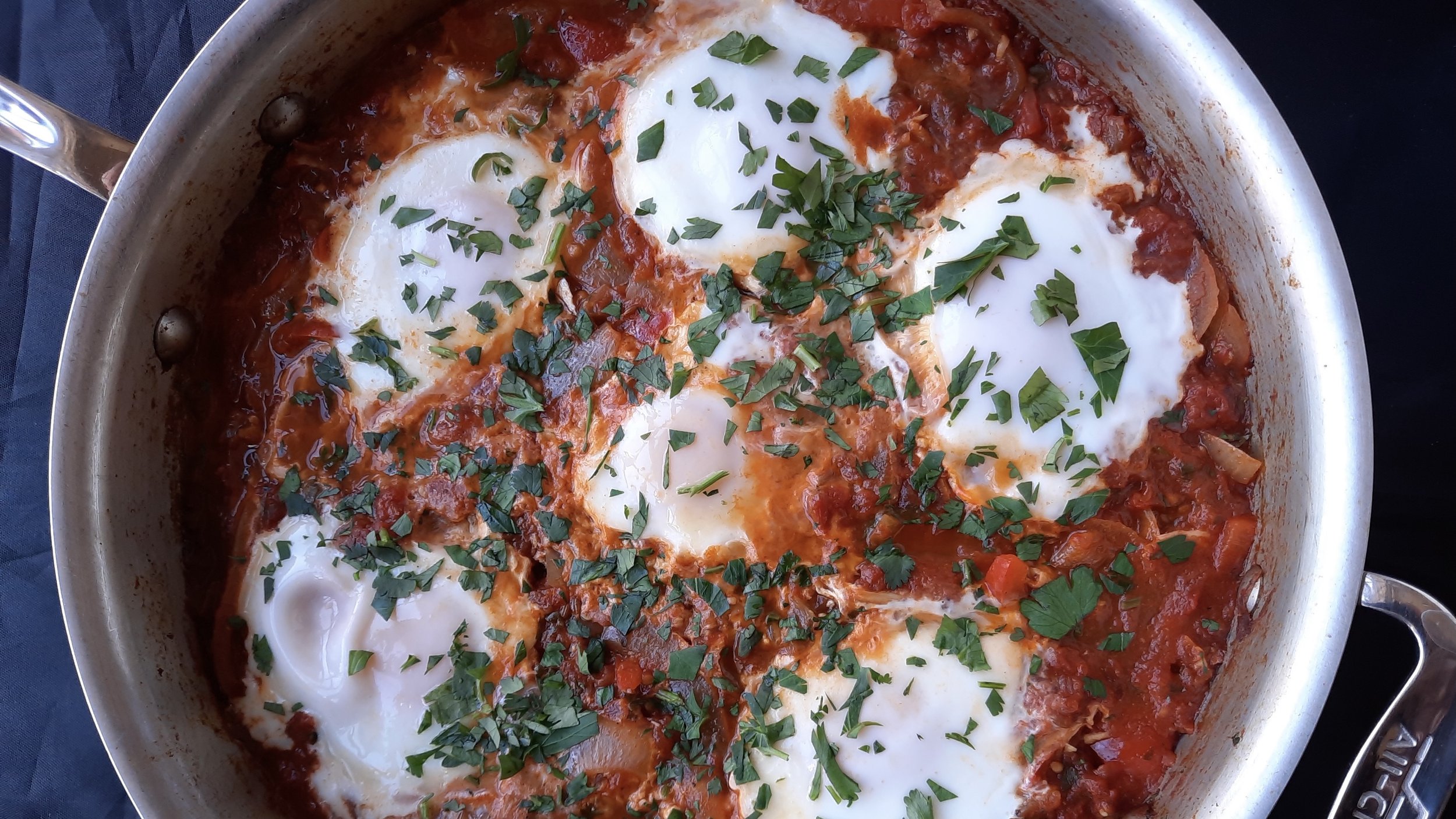SHAKSHUKA
Disputes surround both the name and origin of shakshuka, everyone pointing out that two central ingredients to many recipes—tomatoes and sweet capsicum peppers—wouldn’t have gotten to the areas where shakshuka is widely consumed today, both the Middle East and the Magreb (northwest Africa) until well after Columbus and the Colombian Exchange.
The name may come from a Berber Arabic word meaning “mixture” and any shakshuka is certainly that. Furthermore, any recipe lends itself to nearly endless variation within it. So, experiment with these two recipes yourself, adding in (or emending) spices, various meats such as ground lamb, sausages or pieces of fowl, different vegetables (well, here the list is endless), or cheeses and toppings. You might even scramble in the eggs for a version of a Turkish “shakshuka” called menemen.
A Green Shakshuka
Green Shakshuka
Adapted from cooking.nytimes.com, themediterraneandish.com and downshiftology.com. Serves 4-6.
Ingredients
3 tablespoons fruity olive oil
1 medium yellow onion, peeled and sliced along its “poles”
4 cloves garlic, peeled and thinly sliced or minced
3/4 teaspoon cumin seeds
3/4 teaspoon coriander powder
3/4 teaspoon kosher or sea salt
3/4 teaspoon freshly ground black pepper
8 Brussels sprouts, outer leaves stripped away, cored and finely shredded or very thinly sliced
9 cups blend of baby spinach and baby kale (see note)
1 teaspoon crushed Aleppo (or Urfa or Mexican) red pepper
Juice from 1/2 lemon, seeded
1/2 cup lightly packed cilantro leaves and tender stems, chopped
1/2 cup flat-leaf parsley leaves, chopped, blended with the cilantro
6 large eggs
1/2 avocado, peeled and thinly sliced lengthwise
1/2-3/4 cup cotija cheese, in crumbles, to taste
1 medium jalapeño, sliced thinly into “coins” or rings
1 large scallion, chopped into rings, white and light green parts only
Directions
Follow the initial directions in the first paragraph (only) for Red Shakshuka, above, omitting the red pepper, but using the spices and seasonings called for here.
Add the Brussels sprouts and begin turning everything with tongs. After 5 minutes, add the greens in handfuls and let each batch wilt, again turning with the tongs, until all the greens have gone in. Sprinkle with the lemon juice. (If the greens have not given off much water and the pan appears dry, toss in 1/2 cup water; then another 1/4 cup if needed. At medium-low heat, the contents of the skillet now should be simmering at the edges.)
Make 6 wells with the back of a large spoon, 5 around the perimeter of the greens and 1 in the center. Into each well, carefully break an egg, pushing back toward their yolks the edges of any whites that want to run away. Lower the heat to low and cover the skillet.
After 5 minutes, lightly tap the tops of the yolks to see how far along they’ve come and, if necessary, cook further, covered. (You may serve the shakshuka with runny to medium-firm yolks, as you wish.) Top with the remaining ingredients in any way that suits your fancy.
Note: This blend is readily available in large plastic containers in many grocery produce sections, or you may blend your own. Or use a mix of other moderately sturdy greens such as de-stemmed chard leaves or tender black or red Russian kale.
Red Shakshuka
Adapted and prepared by Bill St. John from seriouseats.com and cooking.nytimes.com. Serves 4-6.
Ingredients
3 tablespoons fruity olive oil
1 medium yellow onion, sliced along its “poles”
1 large red bell pepper, stem, seeds and ribs removed, thinly sliced
4 cloves garlic, thinly sliced or minced
1 tablespoon sweet paprika powder
3/4 teaspoon cumin seeds
1/2 teaspoon cayenne powder, or more to taste
1 teaspoon kosher or sea salt
3/4 teaspoon freshly ground black pepper
1 28-ounce can whole peeled tomatoes (see note)
1/2 cup lightly packed cilantro leaves and tender stems, chopped
1/2 cup flat-leaf parsley leaves, chopped, blended with the cilantro
6 large eggs
Directions
Using a large (at least 10-inch, preferably 12-inch) heavy-bottomed stainless steel or cast iron skillet, heat oil over medium-high heat and in it cook the onion and bell pepper, uncovered, until they soften markedly and begin to brown or blacken in places, about 8-9 minutes. Add the garlic and, stirring, cook 90 seconds more, then make a clearing in the center and add the spices and seasonings, stirring them together until they become aromatic, about 45 seconds more. Mix them in with the onion, pepper and garlic.
Add the tomatoes, crushing them well with your hands as you pour them into the skillet, or alternatively, crush them with a potato masher or pastry blender once they are in the skillet. Reduce the heat to a slow simmer, stirring the mix once or twice, cooking for 10 minutes. Stir in 1/2 the cilantro and parsley (save the remaining 1/2 for garnish) and mix in well.
Make 6 wells with the back of a large spoon, 5 around the perimeter of the shakshuka and 1 in the center. Into each well, carefully break an egg, pushing back toward their yolks the edges of any whites that want to run away. Lower the heat to low and cover the skillet.
After 5 minutes, lightly tap the tops of the yolks to see how far along they’ve come and, if necessary, cook further, covered. (You may serve the shakshuka with runny to medium-firm yolks, as you wish.)
Serve garnished with the remaining 1/2 cilantro and parsley scattered about.
Note: Try not to use canned, diced tomatoes. Almost all brands contain calcium chloride which aids in keeping the tomato dice firm, like small cubes. You don’t want that; you want a smooth, thick, slightly chunky sauce underneath those eggs.

